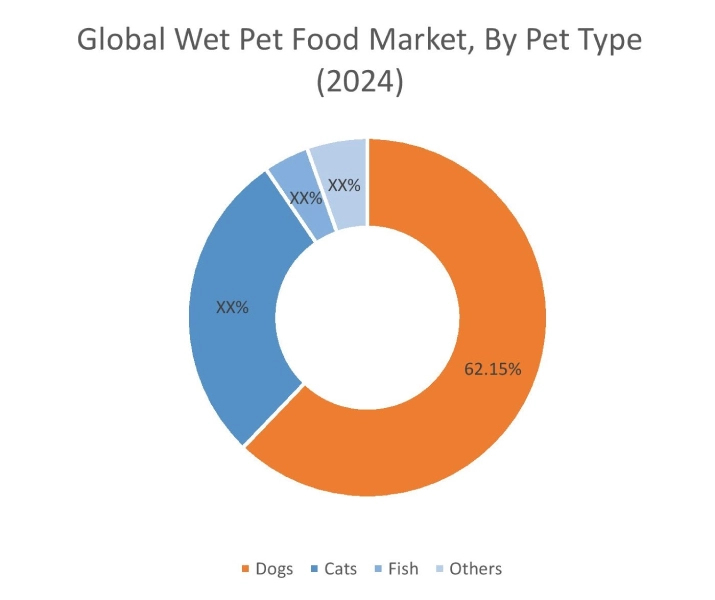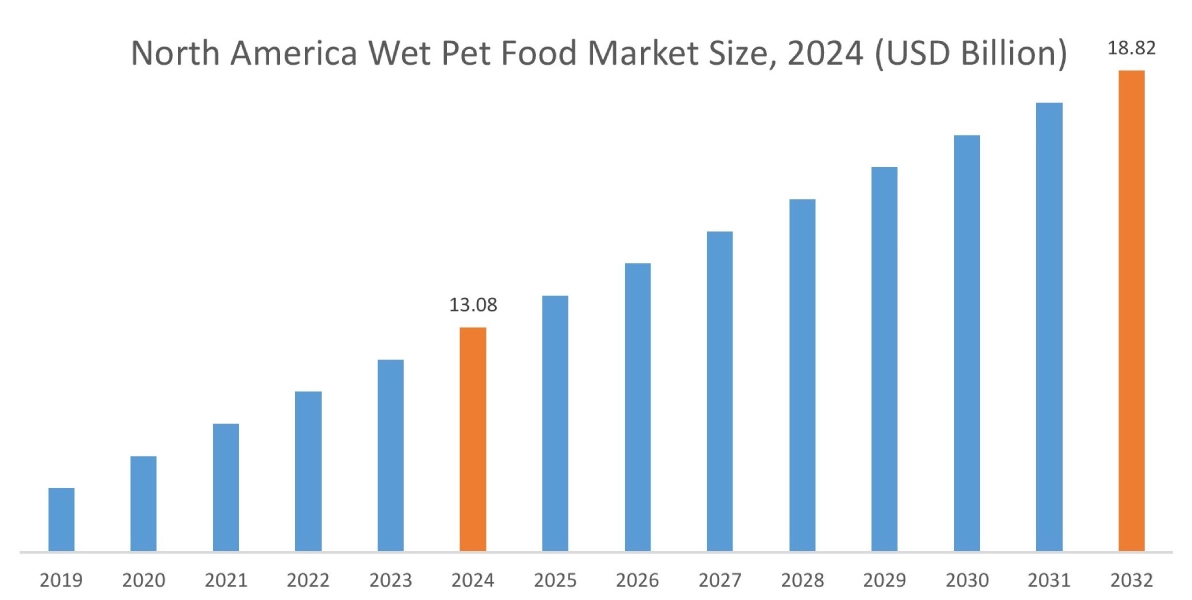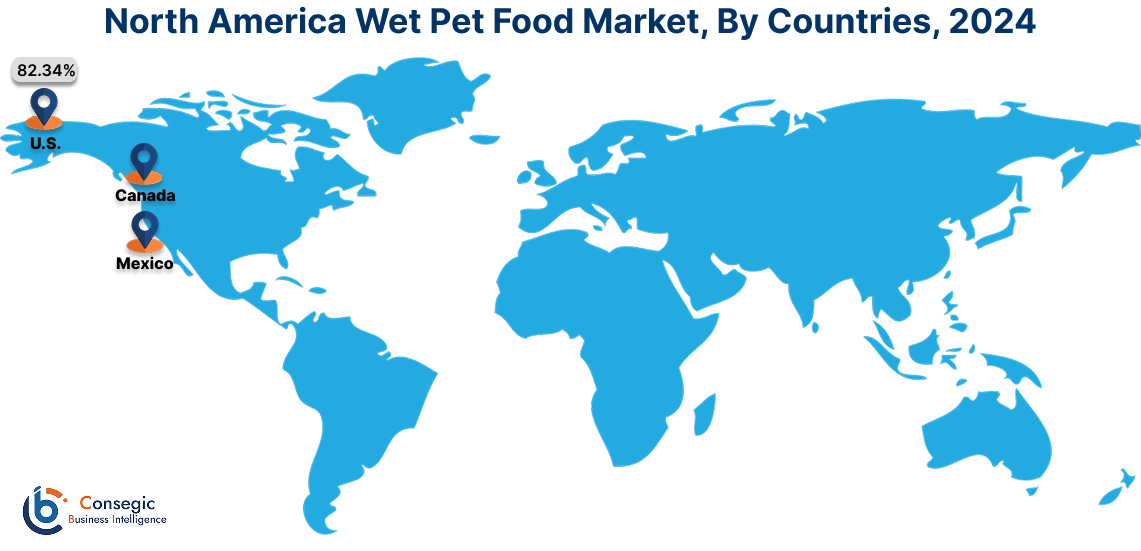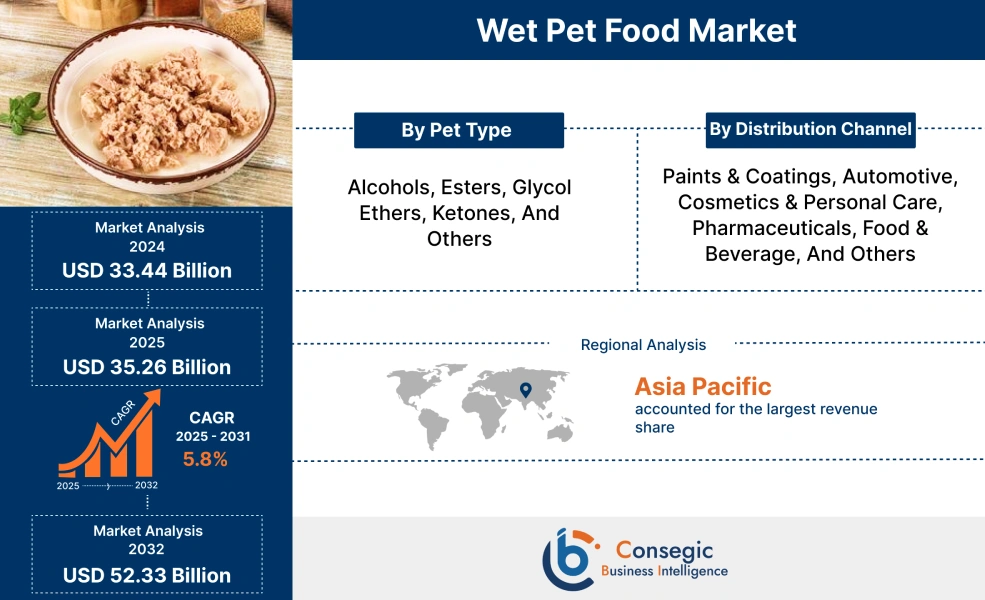Wet Pet Food Market Size:
The Wet Pet Food Market size is growing with a CAGR of 5.8% during the forecast period (2025-2032), and the market is projected to be valued at USD 52.33 Billion by 2032 from USD 33.44 Billion in 2024. Additionally, the market value for 2025 is attributed to USD 35.26 Billion.
Wet Pet Food Market Scope & Overview:
Wet pet food is an option similar to dry food but is prepared commercially, primarily for dogs and cats. It contains a higher moisture content as compared to dry kibble, attributing to roughly more than 60% of moisture content. This pet food mixture is prepared by grating protein such as meat with gravy. This mixture also acts as a source for nutritious food for pets that include essential vitamins and minerals amongst others. This mixture is then cooked and then packaged through canning. This helps to ensure the safety of pet food. The market is classified into two segments, pet type and distribution channel. Pet type segment is further classified into dogs, cats, fish and others. Additionally, the distribution channel is classified into online retailers, hypermarkets/supermarkets, convenience stores, pet stores, others.
Wet Pet Food Market Dynamics - (DRO) :
Key Drivers:
Increasing Pet Ownership is Driving the Growth of the Market.
Pet ownership refers to the relationship between individuals or families and their pets. These pets such as dogs, cats, fish and others are kept primarily for companionship. Wet pet food provides pets with the necessary nutrients to support their development, and overall health in canned form that is easy for the pets to consume. By providing pets with the right nutrients, owners significantly reduce their risk of developing health related conditions. Factors such as growing perception of pets as family members, offering companionship, emotional support, and love are driving the increase in pet ownership.
- For instance, according to International Trade Administration, in 2023, 45% of households in Germany owned a pet, while 14% of these households have two or more pets. Cats and dogs are the predominant household pets, with 25% of German households owning cats and 21% owning dogs in 2023.
Hence, due to the aforementioned factors, increasing pet ownership is driving the wet pet food market expansion.
Swift Humanization of Pets is Accelerating the Market Growth.
Pet humanization refers to the treatment of pets as family members rather than just animals. It reflects a shift in how pet owners perceive their pets, leading to human-like behaviors and lifestyles for animals. Pet owners are searching for food that mimics their own preferences and values, such as health, nutrition, and sustainability. This shift has driven the need for premium pet food products that prioritize high-quality ingredients, high-protein amongst others along with the application of pet wearables to track and monitor the health aspect of the pet.
- For instance, according to a study conducted by Mars Incorporated in 2024, more than 35% of the individuals across the globe that have pets at their home refer to these pets as the one of the most important things in their life.
Thus, owing to the afore-mentioned factors, the swift humanization of pets is accelerating development of the market.
Key Restraints:
Wide Availability of Alternatives to Hinder Wet Pet Food Market Growth.
The availability of alternative pet food options such as dry kibble, semi-moist food, raw food amongst others is significantly impacting the market's development in a negative aspect. Dry kibble is a dominant choice in the overall pet food market due to its affordability and shelf life. These factors align with the needs of pet owners making dry kibble an ideal option thereby limiting the market revenue of wet pet food. Additionally, semi-moist foods offer a convenient alternative along with the increase in need for raw foods contributing to the hinderance in the market. This varied range of options available along with the higher price of wet pet food compared to dry kibble impacts the price-sensitive consumers and presents a considerable hurdle to the market's development. Hence, the aforementioned factors are restraining wet pet food market growth.
Future Opportunities :
Development of Innovative and Palatable Formulations to Create Wet Pet Food Market Opportunities.
Manufacturers are focusing on the development on innovative and palatable formulations in wet pet food by inclusion of flavor profiles, textures and new ingredients to attract a wider range of pets. The production of this type of pet food in traditional nature is heavily based on meat ingredients and standard processing that limits the formulation and texture options. Companies are utilizing technologies such as pet food extrusion amongst others to diverse textures and create more natural flavors, in turn expected to increase the palatability thereby leading to an increase in consumption of wet pet food.
- For instance, in 2025 at Petfood Forum in United States, Jenni Harrington, the directors of technology and sales at Buhler Group stated that High-moisture extrusion (HME), a technique for food processing has the potential to develop new texture, offer greater flexibility amongst others in the wet pet food market.
Thus, due to the aforementioned factors, innovative and palatable formulations is expected to create wet pet food market opportunities.
Wet Pet Food Market Segmental Analysis :
By Pet Type:
Based on Pet Type, the market is categorized into dogs, cats, fish, and others
Trends in Pet Type:
- The growing trend for tailored specific wet food formulations for dogs to address distinct health conditions.
- The high moisture content of wet food is encouraging pet owners to choose it as it is beneficial for cats to support their feline's urinary tract health.
The dogs segment accounted for the largest wet pet food market share of 62.15% in 2024.
- Dog pet food refers to specially formulated food designed to meet the nutritional needs of dogs.
- One of the primary factors contributing to the segment’s dominance is high and growing global dog ownership rates.
- There is an increase in the demand for specialized wet pet food formulations tailored specifically to health concerns related to dogs. These health concerns include joint health, oral hygiene maintenance amongst others.
- Moreover, pet owners are willing to invest in convenient dog food products that has led to manufacturers increasing their capacity, thus driving the demand in the dog segment.
- For instance, in 2024, Mars Incorporated introduced a new product called CESAR® Filets in Gravy Wet Dog Food Mini-Pouch. This product offers pet owners an innovative and convenient way to serve wet pet food to their dogs
- Thus, as per the market analysis, based on the above-mentioned factors, the dog segment dominates the wet pet food market demand.
The others segment is expected to grow at the fastest CAGR over the forecast period.
- The others segment includes pet typers such as birds and other small mammals.
- The rising popularity of these animals as pets is contributing to the increase in the potential pet owner base.
- Additionally, the increasing trend of pet humanization has contributed significantly to a greater willingness among pet owners to invest in premium, palatable options like wet food for their well-being.
- Moreover, the increasing focus towards the trend for a variety in wet formulations specific to birds and other small mammals is further attributing to market’s development.
- Thus, according to the market analysis, owing to the aforementioned factors, the others segment is expected to be lucrative over the forecast period.

By Distribution Channel:
Based on Distribution Channel, the market is categorized into online retailers, hypermarkets/supermarkets, convenience stores, pet stores, and others.
Trends in the Distribution Channel
- The popularity of hypermarkets/supermarkets due to the convenience of one-stop shopping for groceries and pet food and high foot traffic.
- The convenience of e-commerce platforms due to their offering of a wide range options, competitive pricing, and home delivery, is attracting pet owners.
The hypermarkets/supermarkets segment accounted for the largest wet pet food market share in 2024.
- Hypermarkets and supermarkets are large retail stores that offer a wide range of products, including pet food. They are popular among pet owners due to the convenience of being able to shop for multiple pet food types and of varied brands in a single location.
- Currently, pet owners are more cautious when it comes to the quality of food they provide to their pets due to concerns over unsafe or counterfeit products available on the market. Thus, the ability to physically inspect and evaluate products before purchase that are provided by these hypermarkets and supermarkets is contributing to the segmental trends.
- For instance, in 2022, Fressnapf Group, a German-based pet retailer opened more than 100 new locations in Europe. It also stated that it is planning to open 400 new stores by 2025 in Europe.
- Thus, based on the market analysis, as per the aforementioned factors, the hypermarket/supermarkets segment is influencing the wet pet food market trends.
The online retailer’s segment is expected to grow at the fastest CAGR over the forecast period.
- Online pet food sales include purchases that are made through e-commerce platforms such as Amazon, Flipkart, brand-specific websites, and pet-focused online stores.
- One of the key factors for the rise in online pet food sales is the convenience it offers to pet owners.
- Pet owners lead a busy and hectic lifestyle; hence they are more inclined towards the option to shop for pet food without having to visit physical stores. Online platforms enable pet owners to order from the comfort of their homes and have the food delivered directly to their doorsteps, often within a short time frame.
- As a result, owing to the aforementioned factors, the online retailer’s segment is expected to be lucrative over the forecast period.
Regional Analysis:
The regional segment includes North America, Europe, Asia Pacific, the Middle East and Africa, and Latin America.

In 2024, North America accounted for the highest market share at 39.13% and was valued at USD 13.08 Billion and is expected to reach USD 18.82 Billion in 2032. In North America, U.S. accounted for the market share of 82.34% during the base year of 2024. The increase in pet ownership is one of the key drivers for the expansion in North American wet pet food. In addition to this, the rise in disposable income as well as the increase in willingness to purchase premium wet pet food due to the pet health benefits, high moisture content and hydration benefits are contributing to the regional development. Furthermore, the growing influence of millennial and Gen Z pet owners is attributing to market’s development.
- For instance, according to Pure Salmon, the rise in social media has led to an increase in Gen Z individuals connecting with Millennials to share information about products and trends. This has led to an increase in the influence on humanization of pet’s trend in the North American region.
Based on the market analysis, these factors create a strong upward trajectory for the market in North America, positioning it as a key region for players.

In Asia Pacific, the wet pet food industry is experiencing the fastest growth with a CAGR of 7.6% over the forecast period. There is a growing awareness among pet owners in Asia Pacific regarding the health and nutritional needs of their pets. Wet pet food is viewed as a healthier option due to its high moisture content. This helps in hydration and supports urinary tract health that is beneficial for cats. Manufacturers are innovating by including functional ingredients, and high protein content to address specific health concerns in the region.
The humanization of pets is one of the key drivers contributing to the development of the European wet pet food sector. As Europeans increasingly view pets as family, they're more willing to purchase premium pet food products including wet food. This has increased the demand for high-quality pet food formulations catering to specific health needs. The convenience of various wet food formats and the ease of online shopping further drive the market growth. These factors together contribute to the wet pet food market expansion in the region
In the Latin American wet pet food sector, collaboration with veterinarians and pet professionals are creating opportunities for potential development in the region. These veterinarians and pet professionals hold high trust and credibility with pet owners, leading to significantly influence purchasing decisions of wet pet food. Veterinary clinics also serve as key distribution point for specialized diets. Growing awareness by taking initiatives and marketing campaigns to further raise awareness and drive adoption of wet food in the region. Thus, as per the wet pet food market analysis, the above-mentioned factors are contributing to the growth and wet pet food market trends in the region.
Pet owners are increasingly prioritizing high-quality ingredients and seeking out wet food options that offer specific health benefits in Middle East and Africa's wet pet food market. The palatability of wet food also appeals to owners wanting to ensure their pets eat well. Additionally, the increase in humanization of pets translates to a demand for premium, nutritionally balanced wet food. Based on the wet pet food market analysis, these above-mentioned factors are contributing to the wet pet food market demand in the region.
Top Key Players and Market Share Insights:
The Global Wet Pet Food Market is highly competitive with major players providing products to the national and international markets. Key players are adopting several strategies in research and development (R&D) and product innovation to hold a strong position in the global Wet Pet Food market. Key players in the Wet Pet Food industry include
- NESTLE S.A (Switzerland)
- General Mills Inc. (U.S.)
- The J.M. Smucker Company (U.S.)
- Better Choice Company (U.S.)
- Real Pet Food Co. (Australia)
- Mars, Incorporated (U.S.)
- Colgate-Palmolive Company (U.S.)
- Unicharm Corporation (Japan)
- Thai Union Group PCL (Thailand)
- Charoen Pokphand Foods PCL (Thailand)
Wet Pet Food Market Report Insights :
| Report Attributes | Report Details |
| Study Timeline | 2019-2032 |
| Market Size in 2032 | USD 52.33 Billion |
| CAGR (2025-2032) | 5.8% |
| By Pet Type |
|
| By Distribution Channel |
|
| By Region |
|
| Key Players |
|
| North America | U.S. Canada Mexico |
| Europe | U.K. Germany France Spain Italy Russia Benelux Rest of Europe |
| APAC | China South Korea Japan India Australia ASEAN Rest of Asia-Pacific |
| Middle East and Africa | GCC Turkey South Africa Rest of MEA |
| LATAM | Brazil Argentina Chile Rest of LATAM |
| Report Coverage |
|
Key Questions Answered in the Report
How big is the Wet Pet Food market? +
In 2024, the Wet Pet Food market is USD 33.44 Billion.
Which is the fastest-growing region in the Wet Pet Food market? +
Asia Pacific is the fastest-growing region in the Wet Pet Food market.
What specific segmentation details are covered in the Wet Pet Food market? +
By Pet Type and Distribution Channel segmentation details are covered in the Wet Pet Food market.
Who are the major players in the Wet Pet Food market? +
NESTLE S.A (Switzerland), Mars, Incorporated (U.S.), Colgate-Palmolive Company (U.S.), Unicharm Corporation (Japan), Thai Union Group PCL (Thailand), Charoen Pokphand Foods PCL (Thailand) are some of the major players in the market.


